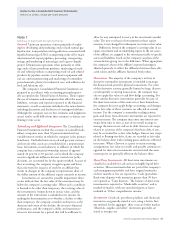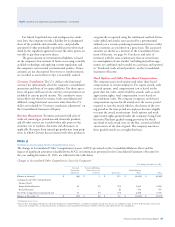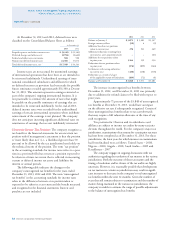Chevron 2013 Annual Report Download - page 45
Download and view the complete annual report
Please find page 45 of the 2013 Chevron annual report below. You can navigate through the pages in the report by either clicking on the pages listed below, or by using the keyword search tool below to find specific information within the annual report.
Chevron Corporation 2013 Annual Report 43
Derivative assets and liabilities are classied on the Con-
solidated Balance Sheet as accounts and notes receivable,
long-term receivables, accounts payable, and deferred credits
and other noncurrent obligations. Amounts not oset on the
Consolidated Balance Sheet represent positions that do not
meet all the conditions for “a right of oset.”
Concentrations of Credit Risk e company’s nancial
instruments that are exposed to concentrations of credit risk
consist primarily of its cash equivalents, time deposits, mar-
ketable securities, derivative nancial instruments and trade
receivables. e company’s short-term investments are placed
with a wide array of nancial institutions with high credit
ratings. Company investment policies limit the company’s
exposure both to credit risk and to concentrations of credit
risk. Similar policies on diversication and creditworthiness
are applied to the company’s counterparties in derivative
instruments.
e trade receivable balances, reecting the company’s
diver sied sources of revenue, are dispersed among the
company’s broad customer base worldwide. As a result, the
company believes concentrations of credit risk are limited.
e company routinely assesses the nancial strength of its
customers. When the nancial strength of a customer is not
considered sufficient, alternative risk mitigation measures may
be deployed including requiring pre-payments, letters of credit
or other acceptable collateral instruments to support sales
to customers.
Note 11
Operating Segments and Geographic Data
Although each subsidiary of Chevron is responsible for its
own aairs, Chevron Corporation manages its investments in
these subsidiaries and their aliates. e investments are
grouped into two business segments, Upstream and Down-
stream, representing the company’s “reportable segments” and
“operating segments.” Upstream operations consist primarily
e table below represents gross and net derivative assets and liabilities subject to netting agreements on the Consolidated
Balance Sheet at December 31, 2013 and December 31, 2012.
Consolidated Balance Sheet: e Eect of Netting Derivative Assets and Liabilities
Gross Amount
Recognized
Gross Amounts
Oset
Net Amounts
Presented
Gross Amounts
Not Oset Net Amount
At December 31, 2013
Derivative Assets $ 732 $ 704 $ 28 $ 27 $ 1
Derivative Liabilities $ 793 $ 704 $ 89 $ – $ 89
At December 31, 2012
Derivative Assets $749$663$86$64$22
Derivative Liabilities $ 812 $ 663 $ 149 $ 5 $ 144
of exploring for, developing and producing crude oil and natu-
ral gas; liquefaction, transportation and regasication
associated with liqueed natural gas (LNG); transporting
crude oil by major international oil export pipelines; process-
ing, transporting, storage and marketing of natural gas; and a
gas-to-liquids project. Downstream operations consist primar-
ily of rening of crude oil into petroleum products; marketing
of crude oil and rened products; transporting of crude oil and
rened products by pipeline, marine vessel, motor equipment
and rail car; and manufacturing and marketing of commodity
petrochemicals, plastics for industrial uses, and fuel and lubri-
cant additives. All Other activities of the company include
mining operations, power and energy services, worldwide cash
management and debt nancing activities, corporate adminis-
trative functions, insurance operations, real estate activities,
alternative fuels, and technology companies.
e segments are separately managed for investment pur-
poses under a structure that includes “segment managers”
who report to the company’s “chief operating decision maker”
(CODM). e CODM is the company’s Executive Commit-
tee (EXCOM), a committee of senior ocers that includes the
Chief Executive Ocer, and EXCOM reports to the Board of
Directors of Chevron Corporation.
e operating segments represent components of the
company, that engage in activities (a) from which revenues are
earned and expenses are incurred; (b) whose operating results
are regularly reviewed by the CODM, which makes decisions
about resources to be allocated to the segments and assesses
their performance; and (c) for which discrete nancial infor-
mation is available.
Segment managers for the reportable segments are
directly accountable to and maintain regular contact with the
company’s CODM to discuss the segment’s operating activities
and nancial performance. e CODM approves annual
capital and exploratory budgets at the reportable segment level,
as well as reviews capital and exploratory funding for major
projects and approves major changes to the annual capital and
Note 10 Financial and Derivative Instruments – Continued
























